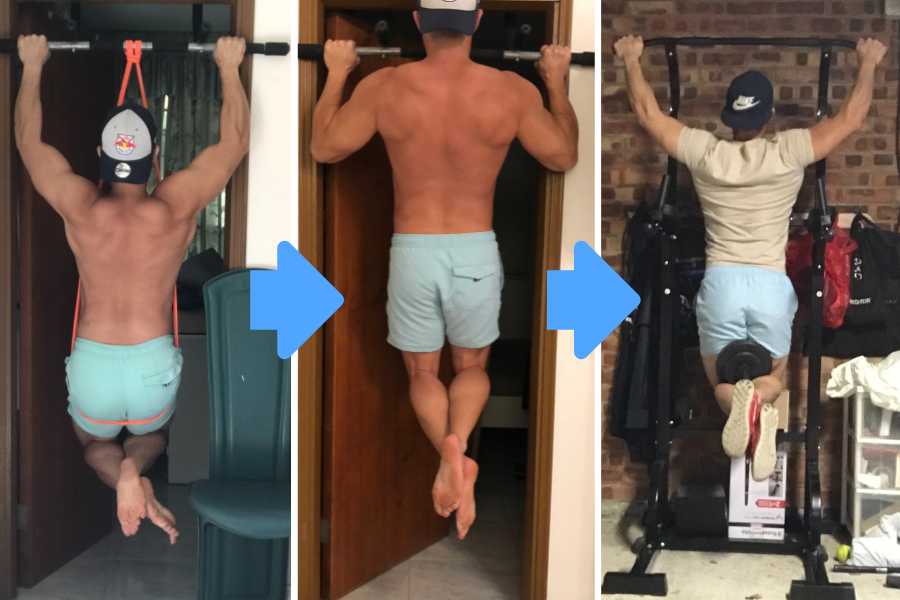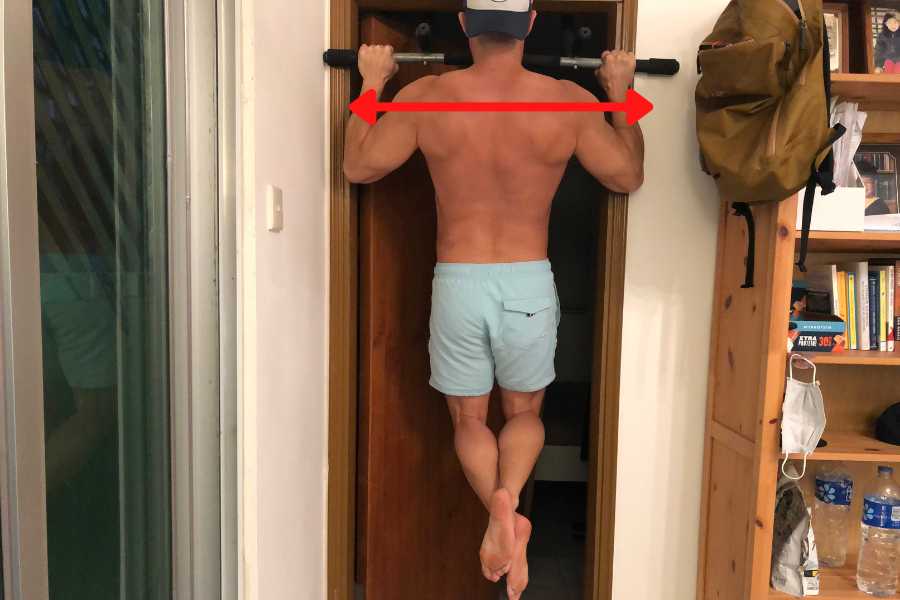Choosing the right weight to lift on pull-ups- whether that be unassisted, assisted, or weighted- is essential for smooth strength progression. But pulling strength varies considerably between individuals. Below, you’ll find my pull-up weight standards.
The average beginner should be able to do a single pull-up with approximately 15% of their body weight in assistance. Intermediates and advanced lifters should be able to do a single weighted pull-up with around 35% and 60% of their body weight added.
The weight standards in this post will help you determine what is a respectable weight to be lifting on the pull-up based on your gender, body weight, and training experience.
Types Of Pull-Ups
For the purpose of definition, my pull-up standards cover the 2 types of pull-ups:
- Weighted (pull-ups with weight attached).
- Assisted (pull-ups with assistance from a machine or bands).
This is a more accurate way to give pull-up standards since most beginners cannot do a traditional bodyweight pull-up.
Weighted pull-ups use external weights (e.g. a dumbbell held between the legs) to add resistance. This is one of the easiest ways to make a bodyweight movement harder and more effective.

Assisted pull-ups use external equipment (e.g. resistance bands) to decrease resistance and make the pull-up easier to perform.

How To Use These Pull-Up Weight Standards

1) Determining your training level:
- Beginners have practiced the pull-up for 1-12 months.
- Intermediates have practiced the pull-up for 12-36 months.
- Advanced lifters have practiced the pull-up for 4 years or more.
2) Choosing your rep range:
The weight standards are given for:
- 1-rep max (1RM)- this is the maximum amount of weight you can lift for a single repetition. It’s often used as a strength standard.
- 6-10 working reps- this is generally considered to be the ideal rep range for building muscle.
3) Selecting your gender and body weight:
- Average pull-up standards are revealed for common body weights.
- Standards are given for males.
- Females can use a 60% conversion (multiply the weight standard by 0.60).
4) Reading the charts:
- Pull-up standards are given as lbs on the top and kg on the bottom.
- + indicates extra weight added to your body weight (i.e. weighted pull-up).
- – indicates weight reduced from your body weight (i.e. assisted pull-ups).
- If you’re doing pull-ups at or above the weight standard for your given training level, body weight, and gender, then you are lifting a respectable amount of weight.
Beginner Pull-Up Standards
Here’s how much weight you should be lifting on the pull-up as a beginner:
| Bodyweight | 1-rep max | 6-rep max | 7-rep max | 8-rep max | 9-rep max | 10-rep max |
|---|---|---|---|---|---|---|
| 120lb 54kg | -20lb -9kg | -35lb -16kg | -36lb -16kg | -36lb -16kg | -36lb -17kg | -37lb -17kg |
| 150lb 68kg | -18lb -8kg | -31lb -14kg | -32lb -15kg | -32lb -15kg | -33lb -15kg | -33lb -15kg |
| 200lb 91kg | -20lb -9kg | -35lb -16kg | -36b -16kg | -36lb -16kg | -36lb -17kg | -37lb -17kg |
| 250lb 113kg | -27lb -12kg | -47lb -21kg | -48lb -22kg | -49lb -22kg | -49lb -22kg | -50lb -23kg |
| 300lb 136kg | -39lb -18kg | -67lb -31kg | -69lb -31kg | -70lb -32kg | -71lb -32kg | -72lb -33kg |
Generally speaking, beginners should be able to do an assisted pull-up with 15% of their body weight in assistance, for a single rep (1-rep max).
Intermediate Pull-Up Standards
Here’s how much weight you should be lifting on the pull-up as an intermediate lifter:
| Bodyweight | 1-rep max | 6-rep max | 7-rep max | 8-rep max | 9-rep max | 10-rep max |
|---|---|---|---|---|---|---|
| 120lb 54kg | +54lb +24kg | +22lb +11kg | +21lb +10kg | +43lb +20kg | +42lb +19kg | +39lb +18kg |
| 150lb 68kg | +66lb +30kg | +26lb +13kg | +27lb +12kg | +26lb +11kg | +25lb +10kg | +24lb +10kg |
| 200lb 91kg | +77lb +35kg | +33lb +16kg | +32lb +16kg | +31lb +15kg | +30lb +14kg | +29lb +13kg |
| 250lb 113kg | +79lb +36kg | +33lb +16kg | +32lb +16kg | +31lb +15kg | +30lb +14kg | +29lb +13kg |
| 300lb 136kg | +75lb +34kg | +31lb +15kg | +30lb +15kg | +29lb +14kg | +28lb +13kg | +27lb +13kg |
Generally speaking, intermediates should be able to do a weighted pull-up with an extra 25-45% of their body weight added, for a single rep (1-rep max).
Advanced Pull-Up Standards
Here’s how much weight you should be lifting on the pull-up as an advanced lifter:
| Bodyweight | 1-rep max | 6-rep max | 7-rep max | 8-rep max | 9-rep max | 10-rep max |
|---|---|---|---|---|---|---|
| 120lb 54kg | +100lb +45kg | +42lb +22kg | +41lb +21kg | +40lb +19kg | +39lb +18kg | +38lb +17kg |
| 150lb 68kg | +117lb +53kg | +49lb +25kg | +48lb +24kg | +47lb +23kg | +46lb +22kg | +45lb +21kg |
| 200lb 91kg | +134lb +61kg | +56lb +27kg | +55lb +26kg | +54lb +25kg | +53lb +24kg | +52lb +23kg |
| 250lb 113kg | +141lb +64kg | +56lb +27kg | +55lb +26kg | +54lb +25kg | +53lb +24kg | +52lb +23kg |
| 300lb 136kg | +141lb +64kg | +56lb +27kg | +55lb +26kg | +54lb +25kg | +53lb +24kg | +52lb +23kg |
Generally speaking, advanced lifters should be able to do a weighted pull-up with an extra 45-80% of their body weight added, for a single rep (1-rep max).
How Good Is Your Pull-Up Standard Vs Others?
Here’s the average percentage of people who can do a pull-up with varying degrees of assistance and added weight:
| Pull Up 1RM Weight (As A Fraction Of Bodyweight) | % Of People Who Can Do It |
|---|---|
| 0.10x | 100% |
| 0.20x | 100% |
| 0.30x | 100% |
| 0.40x | 100% |
| 0.50x | 100% |
| 0.60x | 100% |
| 0.70x | 99% |
| 0.80x | 98% |
| 0.90x | 95% |
| 1.00x | 90% |
| 1.10x | 82% |
| 1.20x | 72% |
| 1.30x | 60% |
| 1.40x | 52% |
| 1.50x | 36% |
| 1.60x | 26% |
| 1.70x | 18% |
| 1.80x | 11% |
| 1.90x | 7% |
| 2.00x | 4% |
The above table allows you to compare your pull-up standard with others.
To calculate your pull-up as a fraction of your own body weight, simply divide the weight of your 1RM by your body weight.
For example:
If you can do an unassisted pull-up (no extra weight or assistance) for 1 rep, then you’re lifting 1.00x your body weight.
And if you weigh 200lbs and you can do a weighted pull-up with a 20lb dumbbell held between your legs for 1 rep, then you’re lifting 1.10x your body weight.
Anything less than 1.00x your body weight is an assisted pull-up.
The above chart indicates:
- 75% of people can pull-up 1.15x their body weight for 1 rep. This represents the lower quartile of lifters and is a respectable weight for beginners to achieve.
- 50% of people can pull-up 1.40x their body weight for 1 rep. This represents the median quartile of lifters and is a respectable weight for intermediates to achieve. It’s also a realistic target for beginners to aim towards with enough training.
- 25% of people can pull-up 1.60x their body weight for 1 rep. This represents the upper quartile of lifters and is a respectable weight for advanced lifters. It’s also a realistic target for intermediates to aim towards with enough training.
Reasons & Solutions For Below-Average Pull-Up Strength
According to a poll I conducted, the back muscles are one of the easiest muscles to build. However, most people (especially beginners) still struggle with the pull-up.
Here are 5 common reasons why you may find the pull-up hard to perform and why your weight standards are below average.
I’ve also shared solutions for each problem. These solutions can help to improve your pull-up strength.
1) Lack of upper body and core strength.

Regardless of variation (assisted, unassisted, or with weights), the pull-up is a hard exercise for most people. It requires a tremendous amount of relative body strength to execute.
Most people who find the pull-up difficult simply lack the upper body vertical pulling strength to perform this exercise.
The pull-up also requires a great degree of core engagement to keep your torso rigid throughout the exercise.
Solution:
The best way to improve your pull-up strength standard is to practice the exercise more.
Beginners can start with assisted pull-ups. Resistance bands are a cost-effective way to do this.
Once you can perform ~8 reps of assisted pull-ups using minimal assistance, you can try ~3 unassisted bodyweight pull-ups and slowly increase reps.
And when you can do ~8 reps of bodyweight pull-ups, you can add weight, decrease reps, and slowly work towards doing 8 repetitions again.
Alternatively, you can try my home routine for skinny guys to build full-body muscle. This will increase your general strength and help you improve your pull-up capabilities.
2) Uncoordinated arm and back muscle activation.

Pull-ups are a complex compound movement. Your back and arms need to activate in sync with each other to efficiently pull your weight towards the bar.
This is a form cue that beginners often miss.
Rather than pulling with the back AND arms, they try to pull with their arms only.
Not only are the arms a much smaller muscle group compared to the back, but pulling with arms only also reduces the number of muscles working to pull you up.
Solution:
Don’t be afraid of using pull-up bands to make the movement easier. As long you find the exercise challenging, bodyweight movements are effective for building muscle and strength, even when assisted.
Begin with band-assisted pull-ups. The reduced weight allows you to focus on perfecting your form.
As you get stronger, you can remove the bands altogether.
At this point, you should have the basic form fundamentals to help you progress onto body weight and weighted pull-ups.
3) Unrealistic pull-up progression plan.
Beginners are often impatient. They expect a full-blown transformation over the period of weeks, when in fact it can actually take up to 6 months or more.
Strength gains come faster than muscle gains.
You should see the first signs of strength gain within the first 1-2 months. The first notable signs of muscle gain can then usually be seen within 3 months.
But to get noticeably stronger and bigger can take half a year to 2 years (depending on your goals).
Solution:
Be patient and accept that it can take 1-3 months of consistent training to do your first unassisted pull-up.
Stick to a good workout plan and complement this with a good bulking diet that’s rich in calories and protein.
Include a selection of exercises to work for each major muscle group, and ensure 10-20 sets of 8-15 reps using a challenging weight are lifted each week.
3 workouts per week are ideal for beginners.
You can check out my other post for more information on how long it takes to build muscle.
4) Incorrect grip placement.

How you hold your bar is important for optimizing your pull-up strength standard.
If your grip is too wide you shift too much emphasis onto the lats. Conversely, if your grip is too narrow, you shift too much focus onto your biceps.
Additionally, most beginners don’t have a strong grip strength to assist with pull-up execution. This takes time to develop.
Solution:
Practice pull-ups with a neutral grip width. This means your hands should be slightly wider than shoulder-width.
Use an overhand grip. This may be challenging at first, but it’s the best way to build your grip strength.
You may also be interested in my other post for a list of interesting pull-up statistics and data examining how pull-up form cues affect performance.
5) Insufficient pull-up training frequency.

Training frequency refers to how often you work out in a week. And optimizing your pull-up frequency is essential to see a good progression.
You can’t just train once a week and expect to see your pull-up strength explode. Nor can you cram all your weekly sets into a single workout.
Why?
Your muscles simply aren’t being worked often enough or receiving enough recovery, for optimal muscle strength and size gains.
Solution:
Spread your 10-20 pull-up sets (I recommend beginners start with 10-12 weekly sets) over 3 workouts.
For a 3-day training split, this equates to around 3-4 sets per workout. Make sure you leave at least 24 hours of rest between workouts.
By doing this, your pull-up muscles should be targeted with enough frequency to drive optimal growth, but not so much that you overtrain.
You may also be interested in my other post on how to tell muscles are growing.
Other Weight Standards For Pull-Up Muscles
The pull-up primarily engages the back and biceps. Here are the weight standards of other exercises that also work similar muscle groups.
- Reverse dumbbell flyes. An isolation-type movement that emphasizes the posterior delts and rhomboids.
- Dumbbell curl. An isolation-type movement that works the biceps.
- Dumbbell rows. A beginner-friendly alternative for working the same muscles as the pull-up.
You may also be interested in my other post for a list of interesting pull-up world records.
Conclusion
I’ve shared pull-up standards based on my personal 5-years of experience in weight training.
Beginners should be able to do 1 pull-up rep with around 15% of their body weight provided in assistance. Intermediates should be able to do a weighted pull-up with approximately 35% of their body weight in added resistance, and advanced lifters approximately 60%.
If you’re lifting at or exceeding these strength standards, then you’re doing a good and respectable job.
I’ve also shared common problems and solutions to a pull-up strength that is below average.
You may also be interested in the downloadable Kalibre Blueprint PDF which details exactly how I gained 40lbs of lean muscle (it’s 100% free!). It details the exact exercises and nutrition (with printables) I used to go from skinny to ripped!


